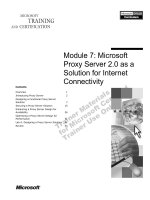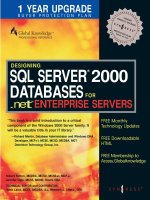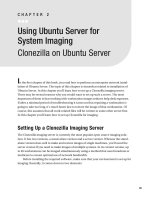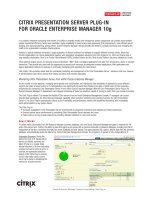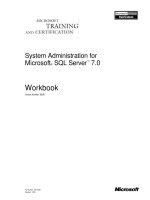Administering ArcGIS for server
Bạn đang xem bản rút gọn của tài liệu. Xem và tải ngay bản đầy đủ của tài liệu tại đây (18.11 MB, 246 trang )
www.it-ebooks.info
Administering ArcGIS for Server
Installing and configuring ArcGIS for Server to publish,
optimize, and secure GIS services
Hussein Nasser
BIRMINGHAM - MUMBAI
www.it-ebooks.info
Administering ArcGIS for Server
Copyright © 2014 Packt Publishing
All rights reserved. No part of this book may be reproduced, stored in a retrieval
system, or transmitted in any form or by any means, without the prior written
permission of the publisher, except in the case of brief quotations embedded in
critical articles or reviews.
Every effort has been made in the preparation of this book to ensure the accuracy
of the information presented. However, the information contained in this book is
sold without warranty, either express or implied. Neither the author, nor Packt
Publishing, and its dealers and distributors will be held liable for any damages
caused or alleged to be caused directly or indirectly by this book.
Packt Publishing has endeavored to provide trademark information about all of the
companies and products mentioned in this book by the appropriate use of capitals.
However, Packt Publishing cannot guarantee the accuracy of this information.
First published: January 2014
Production Reference: 1170114
Published by Packt Publishing Ltd.
Livery Place
35 Livery Street
Birmingham B3 2PB, UK.
ISBN 978-1-78217-736-4
www.packtpub.com
Cover Image by Ravaji Babu ()
www.it-ebooks.info
Credits
Author
Project Coordinator
Hussein Nasser
Joel Goveya
Reviewers
Proofreaders
Paul Crickard
Faye Coulman
Chandler Sterling
Lucy Rowland
Tram Vu Khanh Truong
John (Yiguang) Zhang
Acquisition Editors
Ronak Dhruv
Edward Gordon
Ashwin Nair
Production Coordinator
Lead Technical Editor
Technical Editors
Tejal Soni
Graphics
Rebecca Youe
Anila Vincent
Indexer
Shantanu Zagade
Cover Work
Shantanu Zagade
Pratik More
Mrunmayee Patil
Rohit Kumar Singh
Copy Editors
Alisha Aranha
Brandt D'Mello
Gladson Monteiro
Adithi Shetty
www.it-ebooks.info
www.it-ebooks.info
Foreword
GIS is a mature industry, with its roots in the late 60s in forestry and county
polygon maintenance through vector topology (others such as GRASS and IDRISI
concentrated on the raster domain). Storing location and attribute information has
been a challenge, not only since the early days of severely limited computing power
and storage space, but even today in the management of ever-growing spatial and
tabular repositories. This has been handled in several ways: two tenors being Esri
Arc/Info separating the spatial and the tabular repositories, and Oracle Spatial
embedding them in database tables. Esri evolved from the desktop to the server
by offering SDE, a layer between its data and RDBMS that effectively spatialises
database tables.
After the arrival of the Internet, further web services have been devised by
commercial and open source technologies alike, but that is a subject in its own
right? And while RDBMS scales hardware such as Oracle Exadata, as data expands
to petabytes in real time, a whole other arena such as Amazon services or SAP
in-memory addresses Big Data. But what about big geo data?
ArcGIS for Server is the third generation that adds a host of management, integrity,
and performance tools designed to help implement scalable enterprise GIS.
Hussein is a geo enthusiast, whose chief concern is to make the "Gen 3" mid-section
above amenable to geo experts and project engineers alike. As a practitioner in the
field, he brings a deft touch to the ins-and-outs of this powerful yet complex offering.
Esri being the de facto server geo standard, this book will benefit a wide array of
infrastructure administrators and application engineers. Yet Hussein's clear prose
explains it well enough; his first principles will allow his audience to apply their
lessons learned to other platforms, and therein lies the "sweet spot":
ArcGIS for Server offers interoperability to many other server
and service platforms.
www.it-ebooks.info
This book will thus be a great learning guide to help you understand the
interconnectivity of data and applications. The biggest takeaway may be that
readers will discover the "Internet of things" as a real-world paradigm, rather
than just concepts "in the clouds" or "in the cloud". As an IT and poet friend
once said: "Ladies and gentlemen… start your servers… and let the geo begin!"
Andrew Zolnai
blog.zolnai.ca
Cambridge, UK
www.it-ebooks.info
About the Author
Hussein Nasser is an Esri award-winning Senior GIS Solution Architect at
Electricity & Water Authority, Bahrain. In 2007, he won the first place at the annual
ArcGIS for Server Code Challenge, conducted at the Esri Developer Summit in
Palm Springs, California, for using AJAX technology with ArcGIS for Server, which
was not implemented back then. He spent eight years as a GIS Architect at leading
Middle Eastern engineering company Khatib & Alami, implementing various
Utilities GIS systems based on Esri technology across the Middle East. Hussein then
moved to a more focused environment at Electricity & Water Authority, Bahrain,
his homeland, where he could channel his expertise to develop a robust GIS Utilities
solution and fully integrate it with the e-government project to help Bahrain move
towards the smart grid. In addition, Hussein is fascinated with peak research topics,
including papers he is currently working on: The Human API: A Software Interface to
Prevent Cancer, Global Economic Crisis and Natural Disasters Quantum Detector, and
Stock Market and the Moon Phase.
Writing this book was not easy, however, having the closest people's
support definitely made it enjoyable. I would like to thank my wife,
Nada, who was patient and supportive throughout this journey; I
would stay up at some nights while she made me my favorite tea,
sometimes when I didn't write for a while she would fire up my
laptop, prepare my tea, pair my headset to stereomood.com, and
ask me to resume writing. She even sometimes forced me to take
long breaks when I wrote too much. I would like to thank my mother
for encouraging me to be the best in what I do and for her faith in
me, which lights up in her eyes when I see her. I would like to finally
thank my wise friend, Andrew, for pointing me in the right direction
when I seemed lost. To my family and friends who knew about this
book and encouraged me to finish it, thank you.
www.it-ebooks.info
About the Reviewers
Paul Crickard is a systems administrator in Albuquerque, New Mexico. He
has a master's degree in Political Science and has presented papers at the United
States Naval Academy's Foreign Affairs Conference and the American Journalism
Historians Association Regional Conference in Salt Lake City. He has given
demonstrations on the use of Revit, BIM, and GIS to the Public School Facility
Authority in New Mexico and the Albuquerque BIM505 users' group. Above all, he
is loved and adored by his beautiful wife and son, without whom all other accolades
pale in brilliance.
Chandler Sterling is a GIS Analyst for the City of Pasadena's Department
of Information Technology in California. He attended the University of
Wisconsin-Madison where he earned a graduate capstone certificate in GIS
and a bachelor's degree in Geography and Political Science. He also co-founded
an online resource hub for geospatial learning, the GIS Collective, which can be
found at www.giscollective.org. He enjoys playing music with his band, The
Electric West, and currently lives in Los Angeles.
Tram Vu Khanh Truong received her master's degree in Regional and City
Planning at the University of Oklahoma and has worked in the planning field for
almost four years. Currently, she is a Transportation Planner at the Greensboro
Urban Area Metropolitan Planning Organization. Her duties include GIS
development, data analysis, and Transportation System Planning. Tram Truong
has a passion in utilizing GIS in transportation planning to support decision
making and linking multimodal transportation planning with mixed use of
land development planning.
www.it-ebooks.info
John (Yiguang) Zhang has been in the geospatial industry for over 20 years with
a strong background in GIS, photogrammetry, and remote sensing. He has been
working as a GIS developer and analyst for the past 15 years and has experienced
various GIS projects from start to finish on the GIS application design, development
and implementation, GIS analysis, and map production. He has also managed
complex spatial databases and experienced a lot of spatial data conversion and
integration processes. His creative thinking skills have helped him solve problems
effectively through the course of his career in public and private sectors, such as
city of Chilliwack and Inergraph. He is proficient with Esri ArcGIS family products
including ArcGIS Desktop and ArcGIS Server and spatial database management
systems such as Oracle Spatial, SQL Server, and Open Source PostgreSQL/PostGIS.
He is also competitive in .NET and Web 2.0 technologies. He holds a master's degree
in Digital Photogrammetry and an advanced diploma in GIS from British Columbia
Institute of Technologies, Canada.
Firstly, I'd like to thank my wife, Winnie, for dedicating her time in
taking care of the family, and for her patience with this wonderful
book review and other projects. I would also like to thank my son
Sylvester and daughter Sylvia for their bright ideas to the problems
I had to solve.
www.it-ebooks.info
www.PacktPub.com
Support files, eBooks, discount offers and more
You might want to visit www.PacktPub.com for support files and downloads related to
your book.
Did you know that Packt offers eBook versions of every book published, with PDF and ePub
files available? You can upgrade to the eBook version at www.PacktPub.com and as a print
book customer, you are entitled to a discount on the eBook copy. Get in touch with us at
for more details.
At www.PacktPub.com, you can also read a collection of free technical articles, sign up for a
range of free newsletters and receive exclusive discounts and offers on Packt books and eBooks.
TM
Do you need instant solutions to your IT questions? PacktLib is Packt's online digital book
library. Here, you can access, read and search across Packt's entire library of books.
Why Subscribe?
•
Fully searchable across every book published by Packt
•
Copy and paste, print and bookmark content
•
On demand and accessible via web browser
Free Access for Packt account holders
If you have an account with Packt at www.PacktPub.com, you can use this to access PacktLib
today and view nine entirely free books. Simply use your login credentials for immediate access.
Instant Updates on New Packt Books
Get notified! Find out when new books are published by following @PacktEnterprise on
Twitter, or the Packt Enterprise Facebook page.
www.it-ebooks.info
Table of Contents
Preface1
Chapter 1: Best Practices for Installing ArcGIS for Server
7
Installation tracks
Testing Installation Track
Production Installation Track
Virtualized Environment Installation Track
The anatomy of the Server site
Server site components
Web server
GIS server
7
8
8
8
9
9
9
10
Server site management
11
Testing Installation Track
Server requirements
13
14
Software installation
Configuring Server site
Production Installation Track
Server requirements
15
18
21
22
Services12
Machines
12
Output directories
12
Configuration stores
12
Clusters
12
Data stores
13
Extensions13
Logfiles
13
System requirements
Hardware requirements
System requirements
Hardware requirements
Software installation
14
15
22
23
23
Active Directory configuration
24
www.it-ebooks.info
Table of Contents
GIS server installation
Web server installation
Virtualized Environment Installation Track
Installing Oracle Virtual Box
Adding a new virtual machine
Cloning a virtual machine
Summary
Chapter 2: Authoring Web Services
The classical web service
Creating a classical web service
Enabling ASP on IIS
Writing the web service using ASP
Web services' protocols
The importance of a standard format
SOAP
REST
The Web server
GIS services
Map services
Connecting to the Server site
Disabling automatic data copying
Authoring map services with file geodatabase
Registering the data source
Authoring map service with enterprise geodatabase
Offline authoring and publishing
Protocols enabled for map services
OGC services
Authoring WMS services
Authoring WFS services
25
30
34
35
35
37
38
39
39
40
40
41
44
44
45
47
49
49
49
49
52
52
58
62
64
65
66
66
68
Geoprocessing services
Testing the GIS services
Summary
Chapter 3: Consuming GIS Services
Before you start
Getting the map service URL
Publishing the utility map service
Using GIS services for visualization
Consuming services from the GIS software
Using ArcMap
Using QGIS
Using Google Earth
Consuming services from APIs
Winter is coming – the Flex and Silverlight APIs
[ ii ]
www.it-ebooks.info
69
69
72
73
74
74
76
77
77
78
79
84
87
87
Table of Contents
Using the ArcGIS JavaScript API
Using GIS services for editing
Prerequisites
Setting up the SDE geodatabase
Connecting and registering the SDE geodatabase
Publishing a feature service
Editing feature services using ArcMap
Using GIS services for analysis
Prerequisites
Finding the outage cause – scenario 1
Finding the outage cause – scenario 2
Meanwhile, on the GIS servers
Summary
Chapter 4: Planning and Designing GIS Services
Case study of Bestaurants – the restaurants locator in Belize
Planning GIS services
Analyzing requirements
Nominating GIS services
Option 1 – single service
Option 2 – multiple services
87
94
95
95
96
97
98
101
101
101
105
107
108
109
110
110
110
111
111
111
Designing GIS services
Database design
The Entity-relationship diagram
Optimizing using the database indexing
GIS services design
112
112
113
116
117
Deploying GIS services
Enabling geodatabase
Adding a world basemap
Authoring GIS services
Summary
121
121
126
127
129
Option 1 – single map service
Option 2 – multiple map services
Single or multiple service designs
Chapter 5: Optimizing GIS Services
GIS service instance
Pooling
The anatomy of pooling
Configuring pooled services
Process isolation
High-isolation configuration
Low-isolation configuration
[ iii ]
www.it-ebooks.info
117
120
121
131
131
132
132
134
137
137
138
Table of Contents
Configuring process isolation
Recycling and health check
Caching
Summary
140
141
142
148
Chapter 6: Clustering and Load Balancing
149
Chapter 7: Securing ArcGIS for Server
167
Clustering
Creating clusters
Adding machines to the default cluster
Grouping machines by resources
Mapping GIS services to a cluster
Mapping a simple map service
Mapping a cached map service
Mapping a high-affinity map service
Mapping a geoprocessing service
Scaling clusters
Limitations
Summary
User and role stores
GIS server tier – ArcGIS token security
Enabling the ArcGIS token security
Adding new users and roles
Enabling security on GIS services
Connecting to a secured service
Shared key security
Web-tier – Web server security
Enabling Web Security
Configuring IIS
Adding new users and roles
Enabling security on GIS services
Connecting to a secured service
ArcGIS for Server Manager distilled
Creating users and roles
Testing access control
The administrator directory
Disabling the primary administrator account
Hypertext Transfer Protocol Secure (HTTPS)
Summary
[ iv ]
www.it-ebooks.info
150
150
152
153
157
157
158
159
160
161
164
165
167
168
169
170
172
174
177
178
178
181
181
182
182
183
183
183
187
189
190
191
Table of Contents
Chapter 8: Server Logs
193
Appendix A: Selecting the Right Hardware
211
Appendix B: Server Architecture
215
Logging levels
Log analysis
Exercise – finding the bottleneck
The logfile
Analysis and findings
Clearing Server logs
Summary
Licensing – more machines or more power
Choosing the number of cores
Choosing the size of memory
Summary
The rise of ArcGIS Server
Server architecture 9.x-10.0
SOM and SOC
Web server
DCOM
Benefits of a 64-bit architecture
Summary
193
194
201
201
204
209
209
211
212
213
214
215
216
216
216
217
218
220
Index221
[v]
www.it-ebooks.info
www.it-ebooks.info
Preface
If you are at a library and you grabbed this book, chances are that you have heard
about ArcGIS for Server in a meeting and you want to know what this product is
and what it is capable of. You might have picked up this book because you were
explicitly asked by your manager to investigate the capability of this bleedingedge technology and report with tangible results. Or maybe you are a system
administrator who is in the middle of implementing ArcGIS for Server as your
backbone architecture. Whether you are a curious blogger, a business developer,
or a technical system analyst, I can guarantee that this book won't disappoint you.
Administering ArcGIS for Server was designed for all levels. You might get a
satisfying definition of the product and its components, with comprehensive and
straightforward illustrations, by reading the first chapter of this book. If you want
to just test ArcGIS for Server, you can get it up and running in testing track—a
quick, simple, and efficient method for installation—and do the exercises in most
of the chapters. If you are planning to set up ArcGIS for Server on your production
environment, you can fully read all of the chapters and appendices and explore
the advanced security preferences and performance tips to make your setup
run optimally.
What this book covers
Chapter 1, Best Practices for Installing ArcGIS for Server, introduces the product and
illustrates its architecture and components. It then takes you through three tracks for
installing the product: the simple testing track, the advanced tech-savvy production
track, and finally the last track, which will show you how to set up and configure
ArcGIS for Server specifically as a virtualized environment.
Chapter 2, Authoring Web Services, teaches you the concept behind a web service and
different communication protocols. You will also learn how to author and publish
GIS services so various clients can consume them.
www.it-ebooks.info
Preface
Chapter 3, Consuming GIS Services, illustrates how to consume services that you
learned to author and publish in the previous chapter. You will learn how to
visualize, edit, and analyze services using different clients.
Chapter 4, Planning and Designing GIS Services, is where you will analyze
requirements and plan what services you want to have. You then will use the
planning result to design the services you nominated with rich UML tools. You
will also learn to design the underlying geodatabase, which is the source that feeds
these services.
Chapter 5, Optimizing GIS Services, shows you how to select the correct parameters
and preferences that will make your ArcGIS for Server run at its optimal state.
Optimization techniques such as pooling, process isolation, and caching can be
applied to bring the most out of your ArcGIS for Server and make your services
run much more efficiently and effectively.
Chapter 6, Clustering and Load Balancing, introduces the concept of clustering, a new
technique that allows you to group machines into a cluster. You can then assign
services to run on each cluster based on machine power, memory, or even on
networking factors.
Chapter 7, Securing ArcGIS for Server, introduces different security mechanisms
available on ArcGIS for Server. GIS-tier authentication, Web authentication, and
HTTPS can be applied interchangeably, depending on the security level desired by
your organization.
Chapter 8, Server Logs, will teach you how to harvest the logs and reports generated
by ArcGIS for Server and use them to monitor your system effectively. There are
different levels of logs, ranging from abstract to detailed, and the level you configure
for your setup will depend on how thoroughly you want to monitor your ArcGIS for
Server. Fine and detailed logs come with a performance penalty.
Appendix A, Selecting the Right Hardware, describes how to select the right hardware
for your ArcGIS for Server environment by providing general rules of thumb. I have
come up with formulas that you can use to calculate the number of cores and amount
of memory required to serve your users.
Appendix B, Server Architecture, will display the difference between the old and the
new ArcGIS for Server architecture. You are going to learn how ArcGIS for Server
has survived the 32-bit architecture locking trap and migrated to the more effective
64-bit architecture.
[2]
www.it-ebooks.info
Preface
What you need for this book
You need the following software for this book:
• A Browser, preferably Google Chrome, which you can download from
/>• Esri ArcGIS for Server 10.2 or 10.1, preferably 10.2, which you can download
a trial of from or order
from your local Esri distributor.
• Esri ArcGIS for Desktop 10.2 or 10.1, preferably 10.2, which you can
download a trial of from />or order from your local Esri distributor.
• Microsoft SQL Server Express 2012, which you can download for free from
/>
• Oracle VirtualBox, which you can download for free from
/>
Who this book is for
Whether you are a GIS user, analyst, DBA, system administrator, or programmer
with a basic knowledge of Esri GIS, this book is for you. Although the book is
tailored to fit system administration and analyst requirements, users can find it
equally useful. Each chapter segregates the advanced technical tips from the basic
and required tasks. This makes it easier for users to perform only the necessary steps
to run the software.
Conventions
In this book, you will find a number of styles of text that distinguish between
different kinds of information. Here are some examples of these styles and an
explanation of their meaning.
Code words in text are shown as follows: "Naturally, each GIS server generates its
own logs and this is all saved by default at C:\arcgisserver\logs\."
A block of code is set as follows:
FINE Nov 17, 2013, 11:29:17 AM REST request received. Request size
is 178 characters. Parcels.MapServer
[3]
www.it-ebooks.info
Preface
When we wish to draw your attention to a particular part of a code block,
the relevant lines or items are set in bold:
<%
Dim r
Randomize (Timer)
r = Rnd()
r = r * 100
r = Round(r)
Response.Write(r)
%>
New terms and important words are shown in bold. Words that you see on the
screen, in menus or dialog boxes for example, appear in the text like this: "From
the View Log Messages panel, click on Query to view the current logfiles."
Warnings or important notes appear in a box like this.
Tips and tricks appear like this.
Reader feedback
Feedback from our readers is always welcome. Let us know what you think about
this book—what you liked or may have disliked. Reader feedback is important for
us to develop titles that you really get the most out of.
To send us general feedback, simply send an e-mail to and
mention the book title via the subject of your message.
If there is a topic that you have expertise in and you are interested in either writing
or contributing to a book, see our author guide at www.packtpub.com/authors.
Customer support
Now that you are the proud owner of a Packt book, we have a number of things to
help you to get the most from your purchase.
[4]
www.it-ebooks.info
Preface
Downloading the example code
You can download the example code files for all Packt books you have purchased
from through account at . If you purchased this book
elsewhere, you can visit and register to have
the files e-mailed directly to you.
Errata
Although we have taken every care to ensure the accuracy of our content, mistakes
do happen. If you find a mistake in one of our books—maybe a mistake in the text or
the code—we would be grateful if you would report this to us. By doing so, you can
save other readers from frustration and help us improve subsequent versions of this
book. If you find any errata, please report them by visiting ktpub.
com/submit-errata, selecting your book, clicking on the errata submission form
link, and entering the details of your errata. Once your errata are verified, your
submission will be accepted and the errata will be uploaded on our website, or
added to any list of existing errata, under the Errata section of that title. Any existing
errata can be viewed by selecting your title at />
Piracy
Piracy of copyright material on the Internet is an ongoing problem across all media.
At Packt, we take the protection of our copyright and licenses very seriously. If you
come across any illegal copies of our works, in any form, on the Internet, please
provide us with the location address or website name immediately so that we can
pursue a remedy.
Please contact us at with a link to the suspected
pirated material.
We appreciate your help in protecting our authors' and our ability to bring you
valuable content.
Questions
You can contact us at if you are having a problem with
any aspect of the book, and we will do our best to address it.
[5]
www.it-ebooks.info
www.it-ebooks.info
Best Practices for Installing
ArcGIS for Server
ArcGIS for Server (hereafter known as Server) installation is a challenging task;
use a parameter that does not fit your requirements, hardware, or operating system,
and you will end up with a buggy launch, unexpected errors, and an unstable setup.
This will eventually force you to waste precious time and resources reinstalling and
reconfiguring the product. If you are an ArcGIS user, you will know the pain of
having that one small problem which can only be fixed by completely reinstalling
the product. Therefore, having the right configuration will help you save a lot of
time later and result in a much healthier setup.
In this chapter, we will define the Server site, which holds all configurations,
including web servers, GIS servers, logfiles, and data stores. Then, we will
thoroughly explain the different installation tracks that you can select for
ArcGIS for Server.
Installation tracks
There are three different installation tracks that we will offer in this book.
The Testing Installation Track offers the typical installation with minimum
configuration for those of you who wanted to test the technology. The Production
Installation Track has the comprehensive and best practices configurations. And
finally, the Virtualized Environment Installation Track shows how to configure
Server specifically as a virtualized environment.
www.it-ebooks.info
Best Practices for Installing ArcGIS for Server
Testing Installation Track
If you are a student who wants to explore the ArcGIS technology or an employee
who wants to introduce this product to his/her firm, or just have an older version of
Server that you wish to upgrade, this is a good starting track for you. You can also
select this track if any of the following criteria holds true for you:
• You have a workstation running Windows 8 or 7 and you want to test
this product
• Performance doesn't matter for you at this stage
• You are not behind a proxy server
• You do not want to add multiple servers to your Server site
• You are not concerned about load balancing, a process of balancing the
incoming requests across a spectrum of machines to ensure fair load
distribution on each one of them
• You do not want to publish your services publicly online; rather, you want to
use it on your local area network
• You have a very small user base, for whom you will probably write an
HTML5 site to consume the services from your tablet or phone over Wi-Fi
Production Installation Track
If you already know the product capabilities or have performed a Testing Installation
Track and you are ready to take your Server installation to the next level, go for
Production Installation Track. If you have a powerful server linked to an Active
Directory Domain Controller, which contains the users and roles for Windows,
performance is a key element. You might add other GIS servers to your Server site
later as your user base increases. This track will then help you harness the full power
of Server.
Virtualized Environment Installation Track
For those who have never worked with virtualization before, virtualization is the
process of breaking down a physical machine into multiple virtual machines that
share the host's resources. You can choose to work with Virtualization Track if one
of the following statements holds true for you:
• You do not have access to powerful physical machines, but your company
provides you with powerful blade servers with a virtualization setup
[8]
www.it-ebooks.info


